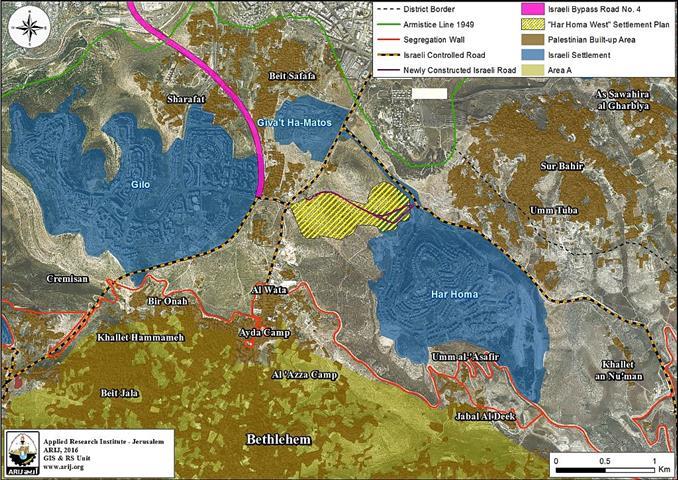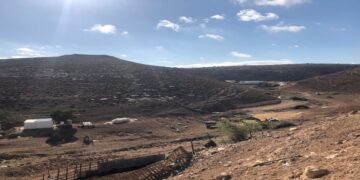The Municipality of Jerusalem and in cooperation with the Israeli transportation ministry started the construction of a new bypass road section and a road interchange that will link the Israeli so-called “Begin Road” or the Israeli bypass Road number 4 with the Israeli bypass road No. 60 (the section locally known to the Palestinians as the Bethlehem-Jerusalem road).
The road interchange will be made via a new tunnel road that will go under the ground, from the southern end point of the under-construction “Begin road – Bypass Road number 4” near Gilo Settlement. The plan holds No. (TPS 258270) and intends to act as an entrance gate to southern Jerusalem settlements.
The municipality of Jerusalem indicated that the plan will be implemented in two levels, an underground tunnel road of 70 meters long with two lanes on each side; and an upper road interchange that will serve the traffic on the road leading to Gilo settlement and its surroundings (and vice versa). The road interchange will also serve the future Jerusalem light rail which is expected to pass via this point. For more information regarding the Jerusalem light rail plan, click here: “New 20 Km Length Path” Israeli Authorities approves the New route of the Jerusalem Light Rail.
The overall cost of the plan amounts to about NIS 120 million, and work is expected to complete in two years[1]. See Map 1
Map 1: The location of the planned underground tunnel and road interchange
Note that the Bethlehem-Jerusalem road was vital before the eruption of the second Intifada in September 2000, and was closed with concrete blocks by the Israeli soldiers soon after the Intifada erupted and a checkpoint was set-up in the place where Palestinians were hindered from accessing it. In 2005, Israel inaugurated the Gilo 300 crossing border, one out of ten other crossings that were constructed along the Segregation Wall path in the West Bank to replace the checkpoint that was in the place that time. Today, Israel treats this terminal as an international border crossing although it is located in the heart of the West Bank.
“Begin Road” or Israeli bypass Road 4
In 2013, the Israeli 'Moriah Jerusalem Development Company' in cooperation with the Israeli Municipality of Jerusalem and the Israeli Ministry of Transportation started working to extend the length of the so called “Menachem Begin Road – Road 4”[1] to penetrate deep inside the 1967 borders, on lands of Beit Safafa and Sharafat south of Jerusalem city under the name 'Road No. 4'. Israeli bypass Road No. 4 is designed to benefit mainly Israeli settlers living in settlements south of Jerusalem, mainly in the Gush Etzion settlement Bloc. in Bethlehem Governorate and settlements in Hebron Governorate who will be able to drive to Jerusalem and to areas inside the 1948 lands without having to stop at any single traffic light. Today, Israel seeks to further increase the length of the road, to further link with the Bethlehem Jerusalem road. For more information, click to read here: “At a cost of USD 1.1 Billion", Israel takes over 234 Dunums of Lands of Beit Safafa and Sharafat to construct the Israeli bypass road No. 4
Not a Coincidence !
Between 2012 and 2015, Israel started constructing another bypass road that extends from the northwest end point of Har Homa settlement and connects with Bethlehem Jerusalem Road, at the Tantour Junction. The construction of this new bypass road will serve plans revealed by the Israeli Municipality of Jerusalem website which indicates the building of a new settlement to the west of Har Homa settlement, identified as “ Har Homa West ” which is planned to include 1600 new settlement units and will occupy a total land area of 445 dunums of lands of Bethlehem, to the south of Saint Elias Monastery. See Map 2
Map 2: The location of planned settlement near Hat Homa, "Har Homa West"
The newly constructed road also connects with Israeli bypass road number 398 which passes by Har Homa settlement from the northeast and continues towards the east to connect with Za’atar bypass road, to finally link with the Gush Etzion bloc- East (the settlements of Nokdim, Tekao, Kfar Eldad Ma’ale Amos, Asfar, Metzad Shimon and other outposts in the area). See Map 2
A Network of bypass roads in the occupied West Bank Territory
Throughout the years of the Israeli occupied of the Palestinian territory, the Israeli Government had constructed a vast network of 'by-pass' roads to link all Israeli settlements, outposts and military bases in the occupied West Bank, thus allowing Israel to maintain full economic and military control of the West Bank. In total, some 820 km were constructed by 2015 (ARIJ).
Given the fact that these settlements and outposts are scattered across the occupied Palestinian territory, the reality on the ground is that this network of bypass roads has dissected the Palestinian territory into isolated areas, disconnected from each other, which in turn, denied Palestinians their right to move freely in the territory they live, in gross contravention of international law which highlights the Israeli policy against Palestinians in the occupied West Bank.
Article 13 of the Universal Declaration of Human Rights states that
- Everyone has the right to freedom of movement and residence within the borders of each state.
- Everyone has the right to leave any country, including his own, and to return to his country.
Also article 12 of the International Covenant on Civil and Political Rights entail the right to move freely from one place to another within the state.
- Everyone lawfully within the territory of a State shall, within that territory, have the right to liberty of movement and freedom to choose his residence.
- Everyone shall be free to leave any country, including his own.
- The above-mentioned rights shall not be subject to any restrictions except those which are provided by law, are necessary to protect national security, public order, public health or morals or the rights and freedoms of others, and are consistent with the other rights recognized in the present Covenant.
- No one shall be arbitrarily deprived of the right to enter his own country.
[1] זינוק בעלייה: החלה הבנייה להקמת מחלף רוזמרין
https://www.jerusalem.muni.il/Municipality/Msg_84/Pages/ZinukBaliya.aspx
Prepared by:
The Applied Research Institute – Jerusalem















